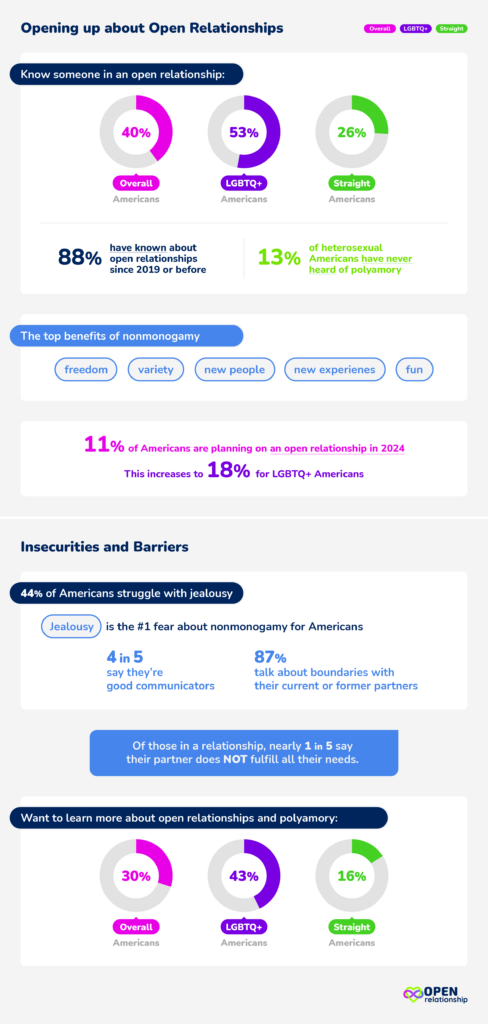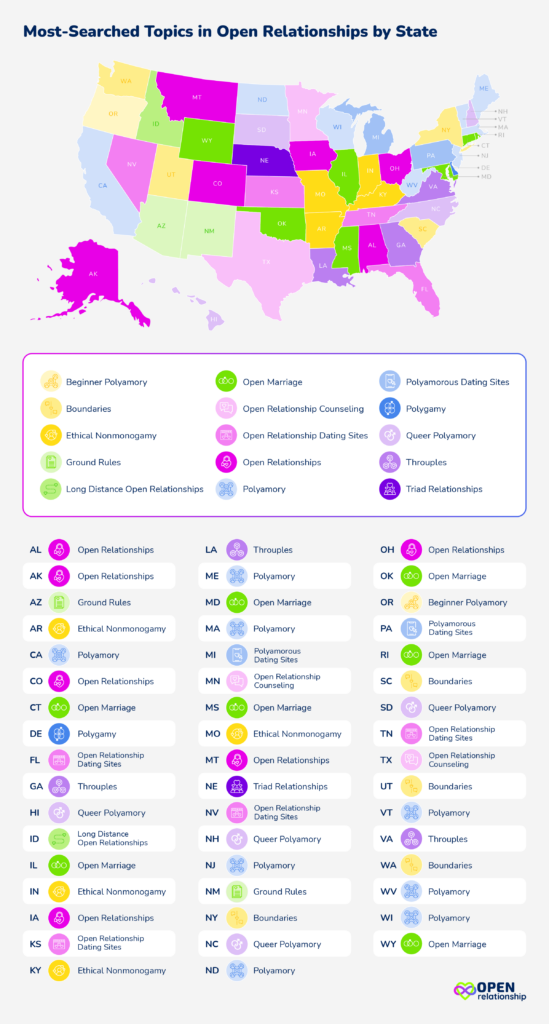Open relationships and polyamory are having a “moment,” according to The Week. As more people, both single and in relationships, monogamous and non-monogamous, LGBTQ+ and heterosexual, learn more about open relationships, the more the practice and curiosity about it grows.
OpenRelationship, a dating app and website that offers modern dating for everyone, wanted to know what is common knowledge about open relationships and polyamory, and what still requires education. The study combined a nationwide survey, focusing on LGBTQ+ and heterosexual Americans, to see what people know, and what they don’t.
How Many People Know Someone in an Open Relationship?

Open relationships are more popular than one might think, particularly if they are part of the LGBTQ+ population. Overall, about 2 in 5 Americans know someone in an open relationship; for queer Americans, this skyrockets to over half at 53%. For straight Americans, just over 1 in 4 know someone in an open relationship.
For those who practice non-monogamy, the top benefits include freedom, variety, new people and experiences, and fun. These benefits are appealing to many, as 1 in 10 Americans are planning on opening up their relationships in 2024; for the LGBTQ+ population, this increases to nearly 1 in 5 at 18%.
Many people have found that while they love their partner, they aren’t “their everything.” In fact, 1 in 5 Americans in a relationship says their partner does not fulfill all their needs. This is where exploring an open relationship may be something to discuss.
This prospect is so appealing that 30% of Americans want to learn more about open relationships and polyamory– including 43% of queer people.
Top Terms in Open Relationships

While Americans straight and queer alike know what an open relationship is, a clear trend across open relationship and polyamory literacy is the deeper knowledge of the LGBTQ+ population about all things open relationship. For nearly every term, there’s a difference of at least 10 percentage points, with standouts including knowing what a polycule is, what ethical non-monogamy is, and knowing the differences between polyamory and polygamy.
Generally, terms pertaining specifically to open relationships and inclusive dating tend to have more widespread knowledge, like being able to tell the difference between open relationships and swinging. More niche terms like “metamour” tend to be less well known, with only about 1 in 6 Americans knowing that a metamour is the partner of someone you’re dating.
The Hottest Open Relationship Topics in Every State

Some states are more interested in specifically open marriages, including Connecticut, Maryland, Illinois, Mississippi, Oklahoma, and Rhode Island. Florida, Kansas, Nevada, and Tennessee want to jump right in and find open relationship dating sites, while Minnesota and Texas are embracing emotional health and seeking open relationship counseling. Idaho is in a state of yearning in its search for long-distance open relationships, while Georgia, Louisiana, and Virginia are interested in throuples, and Nebraska is interested in triad relationships.
The LGBTQ+ population is especially vocal in Hawaii, New Hampshire, North Carolina, and South Dakota, with “queer polyamory” the most searched topic in those states. Delaware appears to be curious about polygamy, while Oregon is most interested in polyamory for beginners.
Some states are more intrigued by the basic vocabulary of open relationships: Arizona and New Mexico search the most for ground rules in a relationship, while New York, South Carolina, Utah, and Washington want to learn more about relationship boundaries.
Frequently Used Terms in Open Relationships
Since the world of open relationships and polyamory has its own set of terms and concepts, we’ve compiled a helpful guide to some of the top terms you might encounter:
- Ethical Non-monogamy: Ethical Non-monogamy is the practice of dating or being in a relationship with multiple parties in a way that protects the feelings of all parties involved, prioritizing open and honest communication
- Metamour: A metamour is someone dating or in a relationship with a person you are dating or in a relationship with
- Open Relationship: An open relationship is a committed relationship in which one or both partners also date or have sexual relations with other people outside the core relationship
- Polycule: A polycule can be an open or closed group of people who are all in a relationship with each other; a closed polycule is exclusive to itself, while an open polycule involves dating outside the core relationships and people involved
- Polyamory: Polyamory is the act or practice of engaging in romantic or sexual relationships with multiple partners
- Polygamy: Polygamy is the practice of having multiple married partners of a certain gender; for example, a man might have more than one wife. This practice is illegal in the United States.
- Primary Partner: A primary partner is the person prioritized over other relationships within an open relationship or polyamorous relationship; for example, the husband-wife relationship in an open marriage is prioritized over other partners
- Relationship Boundaries: Relationship boundaries are ground rules or guidelines around communication or interaction within the context of a relationship. Often this helps define what a person is and is not comfortable with; e.g., in an open relationship, whether involved parties are comfortable with a sexual relationship outside the primary partnership
- Swinging: Swinging is a type of open relationship or polyamorous practice in which groups including singles and couples may swap partners, engage in group sex, or other combinations thereof. It is sometimes referred to as “the lifestyle.”
- Throuple: A throuple is a committed relationship of three people; sometimes it is an open relationship in which both partners date the same third person, and sometimes it is a true three-way relationship without hierarchy.
Methodology
In February 2024, we conducted a survey of 485 heterosexual Americans and 503 LGBTQ+ Americans to see their overall knowledge of open relationships and polyamory terms.
For heterosexual Americans, ages ranged from 18-76 with an average age of 42. Respondents were 50% men and 50% women. In terms of relationship status, 36% are married, 38% are single, 14% are in a non-marital relationship, and 9% are divorced. The remainder are separated or widowed.
For LGBTQ+ Americans, ages ranged from 18-82 with an average age of 37. Respondents were 45% men, 45% women, and 10% nonbinary. In terms of relationship status, 34% are single, 29% are married, 3% are divorced, and 32% are in a non-marital relationship. The remainder were separated or widowed.
To determine topics in open relationships and polyamory by state, we analyzed 1,979 terms having to do with polyamory and open relationships like “poly dating apps” or “trying an open relationship.” We analyzed search term volume by state over the past 12 months, grouping like terms together to find a topic for each state.
For media inquiries, contact [email protected].
Fair Use
When using this data and research, please attribute by linking to this study and citing openrelationship.com


